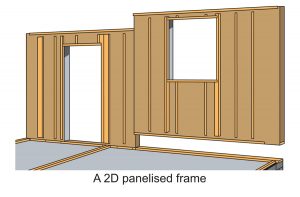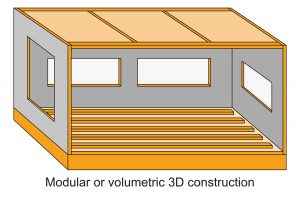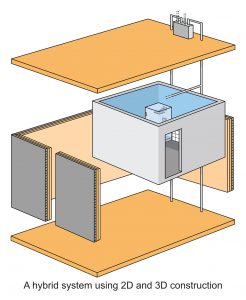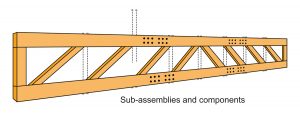TRADA examines the offsite construction landscape and asks if the right drivers and economic conditions are in place for a step-change in its adoption
Offsite construction is based on two key principles: efficiency and quality. It involves the manufacture and preassembly of components, elements or modules before installation into a final location. The construction value-added on site is less than 40% of the final construction value at completion.
Offsite construction can be split into four broad categories of panelised, modular/volumetric, hybrid and subassemblies/components, of which there are subcategories relative to the level of enhancement. (Figure 1) Offsite construction allows parts of the building to be premanufactured in an environment suited for effective production, where, if appropriate, advanced equipment can be used to increase productivity.
Offsite construction also improves working conditions by taking construction processes to a clean, controlled environment, unaffected by climatic conditions. Ideally, as many parts of the building will be finished to as high a level of completion as possible to minimise work on site. Table 1 contains a range of terminologies often used to describe offsite or industrialised forms of construction.
Figure 1: Forms of offsite construction




Table 1: Other offsite terminologies

Current UK context for offsite construction
In 2015, the UK construction market was ranked fifth out of the eight nations that account for 70% of the $10trn global construction market. In 2017, the UK population was 64.2m, projected to increase to 72.1m by 2047. This figure, combined with changing demographics resulting in a higher proportion of one- and two-person households and assisted-living requirements, will continue to place significant pressure on existing societal infrastructure such as schools, healthcare and housing.
There are 1.5m households on the UK housing waiting list; the total number of new homes required to be built is predicted to be 295,000 per year until 2037, plus 15,500 care and retirement buildings by 2035. Given this context, the most recent UK government Construction 2025 strategy set out improvement targets of:
- Lower costs: 33% reduction in both the initial cost of construction and the whole-life cost of assets.
- Faster delivery: 50% reduction in the overall time from inception to completion for new build and refurbished assets.
- Lower emissions: 50% reduction in greenhouse gas emissions in the built environment.
- Improvements in exports: 50% reduction in the trade gap between total exports and total imports for construction products and materials.
Recent estimates of offsite construction in the UK are approximately £1.5bn to £6bn per year in terms of construction output of a £90bn construction market. An accurate valuation of the sector is difficult given its relatively fragmented nature and the ambiguity of what constitutes offsite when considering the level of enhancement or value added.
However, it is apparent that, for offsite construction to be a vehicle for delivering the built environment, it requires large-scale operation. For this to take place, there must be a change in construction culture, including multi-skilling, interdisciplinary collaboration and greater flexibility within a number of job roles. These drivers, as well as others such as regulatory, digitisation/Building Information Modelling (BIM) and the need for improved levels of productivity, must intersect appropriately within the given economic context.
It has been demonstrated throughout construction history that successful construction methods only endure when positioned at the correct intersection of such drivers with the overall economic context critical for scale. Currently in the UK, there is certainly a need and government willingness for offsite construction. In 2017, the government announced that the Department for Transport, the Department of Health & Social Care, the Department for Education, the Ministry of Justice, and the Ministry of Defence would all adopt a presumption in favour of offsite construction by 2019 across suitable capital programmes, where it represents best value for money.
The UK government has now committed to changing its procurement model in favour of offsite construction by means of ensuring the public sector can procure for whole-life value rather than upfront cost. A House of Lords Science & Technology Select Committee report – Offsite Manufacture for Construction: Building for Change – has endorsed this approach and encourages future research and development of offsite construction to focus on demonstrating the full lifetime value that it can bring; it also encourages the UK government to consider tax incentives.
This is an extract from TRADA publication Offsite and industrialised timber construction: Delivering quality and efficiency 2nd edition. Visit TRADA.co.uk to find out more about the publication.
TRADA
+44 (0)1494 569603
Twitter: @TRADA_
LinkedIn: TRADA













